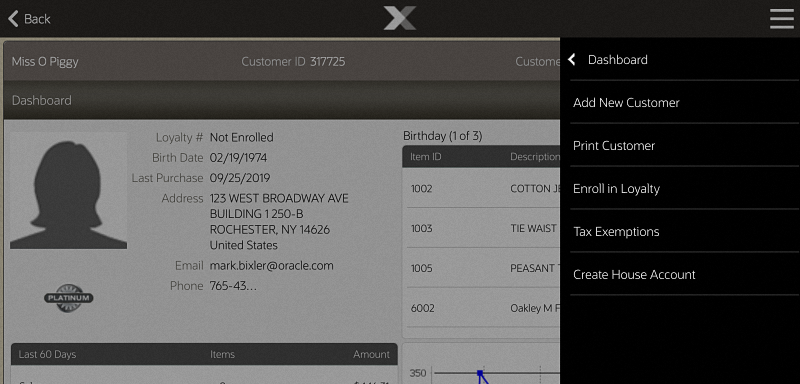29 Customer Maintenance
Customer Maintenance includes activities that relate to entering new customers into the customer database, updating customer information, viewing or printing customer information, and deleting a customer record.
Customer Maintenance is typically required when an associate discovers that a customer's name is not in the database and must be entered for the first time. Other common situations that trigger customer maintenance occur when incorrect customer information is found and must be revised, and when information is lacking and must be entered.
Note:
Customer maintenance activities are controlled by user security. An associate must have privileges in the system to perform any customer maintenance activities.
The Customer Maintenance screen is divided into several tabs containing information about the customer.
Figure 29-1 Customer Maintenance - Tab Selection
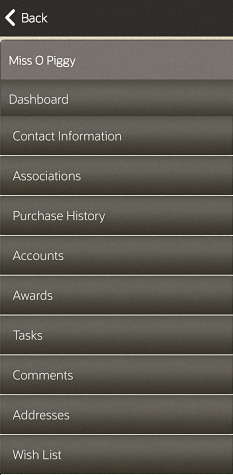
Dashboard Tab
Figure 29-2 Customer Maintenance - Dashboard Tab
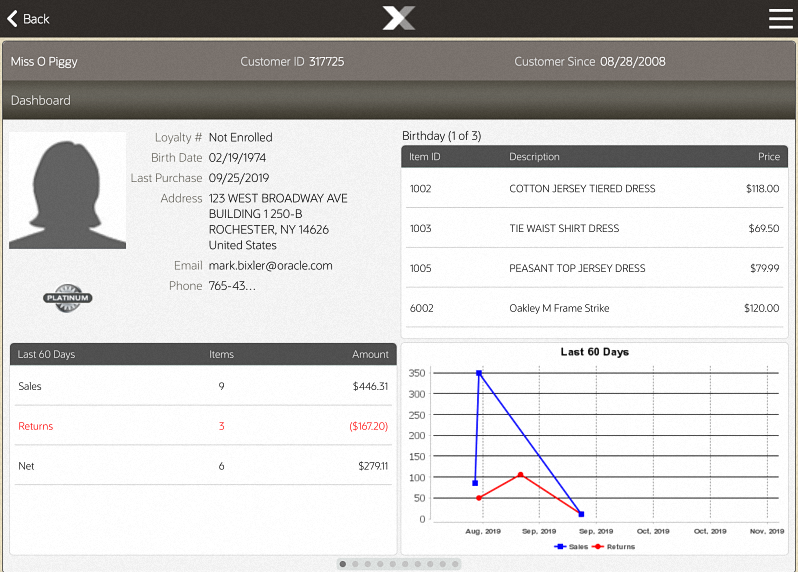
The Dashboard tab displays the following information:
-
Loyalty #: Loyalty number.
-
Birth Date: Date of birth.
-
Last Purchase: Last purchase date.
-
Address: Primary address.
-
Email: Primary e-mail address.
-
Phone #: Primary phone number.
-
Summary of the transactions in the last year. See Transaction Summary.
-
Wish List: Items in the customer's wish list.
-
Last 365 Days: Graph of the transactions in the last year.
Transaction Summary
The transaction summary table displays the following columns:
-
Last 365 Days: Types of transactions performed in the last year.
-
Items: Total number of items in the transaction type.
-
Amount: Total amount in each transaction type.
Contact Information Tab
Figure 29-4 Customer Maintenance - Contact Information Tab
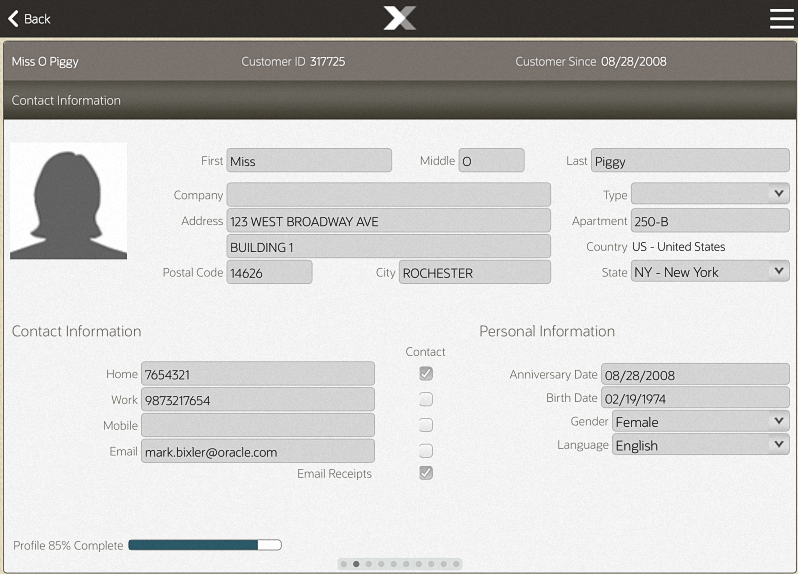
The Contact Information tab contains the following fields:
-
First: First name.
-
Middle: Middle name or middle initial.
-
Last: Last name.
-
Company: Company or organization associated with the customer.
-
Type: Type of company or organization.
-
Address: Primary street address.
-
Apartment: Primary address apartment.
-
Country: Country of primary address.
-
Postal Code: Postal or zip code.
-
City: City of the primary address.
-
State: State or province of the primary address.
-
Home: Home telephone number.
-
Work: Work telephone number.
-
Mobile: Mobile telephone number.
-
Email: Primary e-mail address.
-
Contact: Indicates whether the customer permits the store to contact them through the associated telephone number or e-mail address.
-
Email Receipts: Indicates whether the customer allows the store to send e-mail receipts to the primary e-mail address.
-
Anniversary Date: Date on which the customer was added to the system.
-
Birth Date: Customer birthdate.
-
Gender: Customer gender.
-
Language: Primary language for the customer.
-
Profile x% Complete: Percentage of customer record completion.
If Customer Information Consent functionality is enabled, the consent preferences are accessible via the Review Customer Consent option within the Customer Options menu.
Associations Tab
Figure 29-5 Customer Maintenance - Associations Tab
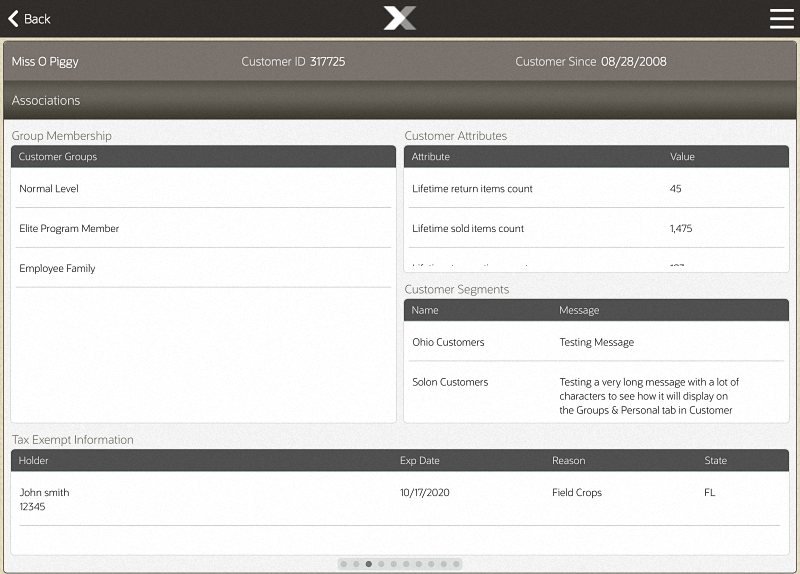
The Associations tab contains the following fields:
-
Group Membership: The group to which the customer belongs. Groups are defined by the store or home office. A customer may be associated with one or more groups. If groups are not defined, no customer groups are listed in this section.
-
Customer Attributes: Attributes for the customer. Attribute categories are defined by the home office and provide additional information about the customer.
-
Customer Segments: Segments to which the customer belongs. Segments are groupings that share common criteria. This information is provided by Customer Engagement. Identifying a customer with a segment may be helpful in customer analysis and in sale promotions.
Note:
This field cannot be edited. Segments are provided by Oracle Retail Customer Engagement.
-
Tax Exempt Information: Tax exemptions associated with the customer. A customer may have one or more exemptions.
Purchase History Tab
Used as a method of establishing a customer's purchase history from the past.
Figure 29-6 Customer Maintenance - Purchase History Tab
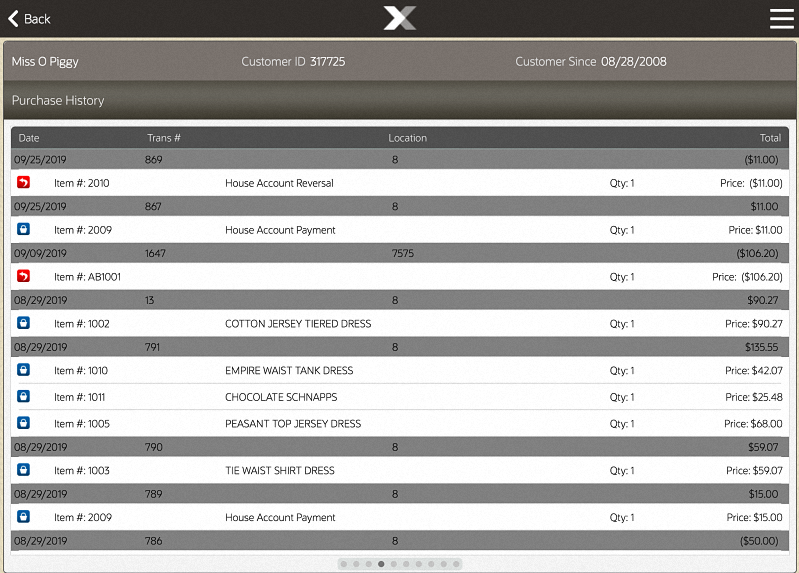
This tab shows detailed information about sales transactions for the customer within the last 365 days. This tab displays the following rows:
-
Transaction Row - Displays information about a transaction.
-
Item Row - Displays information about an item within a transaction.
-
Item Information - Displays information about a selected item.
Note:
This field cannot be edited. Segments are provided by Oracle Retail Customer Engagement.
Transaction Row
Transaction rows display the following information:
-
Date: Date of the transaction.
-
Trans #: ID number of the transaction.
-
Location: Location ID.
-
Total: Total amount of the transaction.
Accounts Tab
Figure 29-7 Customer Maintenance - Accounts Tab
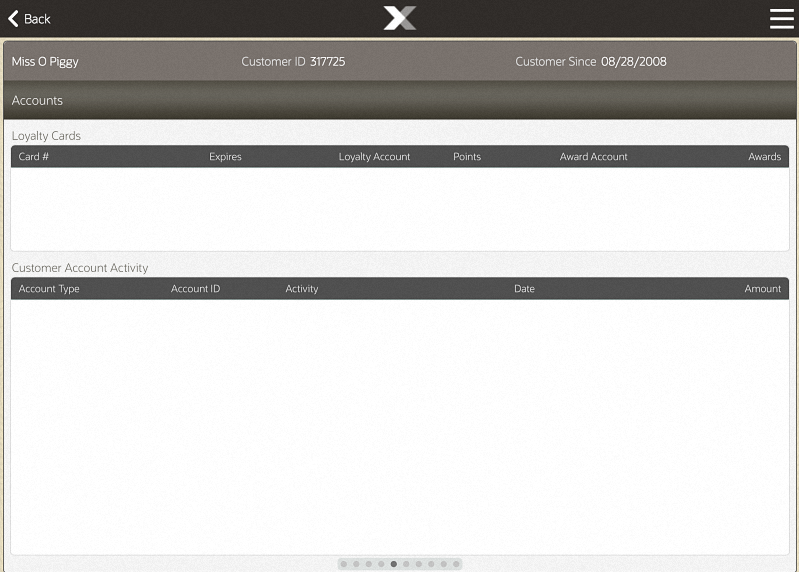
Your system's configuration determines the information displayed on this tab.
If your system is configured for a loyalty program, this tab lists the customer's loyalty program information.
If your system is not configured for a loyalty program, this tab lists any of the customer's special accounts such as work order accounts, layaway accounts, pre-sale accounts, hold accounts, and send sale accounts.
Note:
The information in this tab cannot be edited.
Loyalty Configured
If loyalty is configured on your system, the Accounts tab will display the following information:
-
Loyalty Cards - Information about the loyalty cards associated with the customer.
-
Customer Account Activity - Loyalty activity for the customer.
Loyalty Cards
This section displays the following information for each loyalty card:
-
Card #: Card number.
-
Expires: Card expiration date.
-
Loyalty Account: Loyalty account ID.
-
Points: Number of points accumulated in the loyalty account.
-
Award Account: Award account ID.
-
Awards: Awards in the awards account.
Customer Account Activity
This section displays the following information about the customer's account activity:
Note:
Activity rows that have been voided show a line through the entire row.
-
Account Type: Type of customer account.
-
Account ID: ID of the account.
-
Activity: Type of activity.
-
Date: Date of the activity.
-
Amount: Amount associated with the activity.
Context Menu Buttons
The Account tab includes the following options specific to this tab:
-
Print Balance Receipt: Prints a receipt showing loyalty account balance information.
-
Print Loyalty History: Prints a Loyalty Account History report on the report printer. The information in this report includes the information shown in the Customer Account History section of the Account tab. This report provides current and historical information about a customer's loyalty accounts. See the Oracle Retail Xstore Point of Service Reports Guide for more information about this report.
No Loyalty Programs
If loyalty programs are not used by your system, the Accounts tab will display the Customer Account Detail information.
The Customer Account Detail lists special accounts that are owned by the customer. The account status (such as OPEN or CLOSED) is noted along with a date and current amount due on the account if applicable.
Awards Tab
Figure 29-8 Customer Maintenance - Awards Tab

The Awards tab is for viewing the customer's current awards and entitlements information in separate sections. You can edit the customer and loyalty information within customer maintenance but the award and entitlement information are for viewing only. You cannot apply the awards or entitlements to the transaction from this screen.
Tasks Tab
Figure 29-9 Customer Maintenance - Tasks Tab

The Tasks tab displays all tasks associated with the customer. This tab displays the following information for each task:
-
Priority: Importance of the task: high, medium, or low.
-
Date: Date the task should begin.
-
Start Time: Time the task should begin.
-
Duration: Length of time designated for the task.
-
Activity: Type of task.
-
Status: Indicates the progress of the task.
-
Associate: The employee or employee group responsible for completing the task.
Status
The status field can have one of the following values for a task:
-
Open: The task is open, but not started.
-
In Progress: The task has been started, but not completed.
-
Cancelled: The task has been cancelled and cannot be reopened or edited.
-
Closed: The task has been completed and cannot be reopened or edited.
Comments Tab
Figure 29-10 Customer Maintenance - Comments Tab
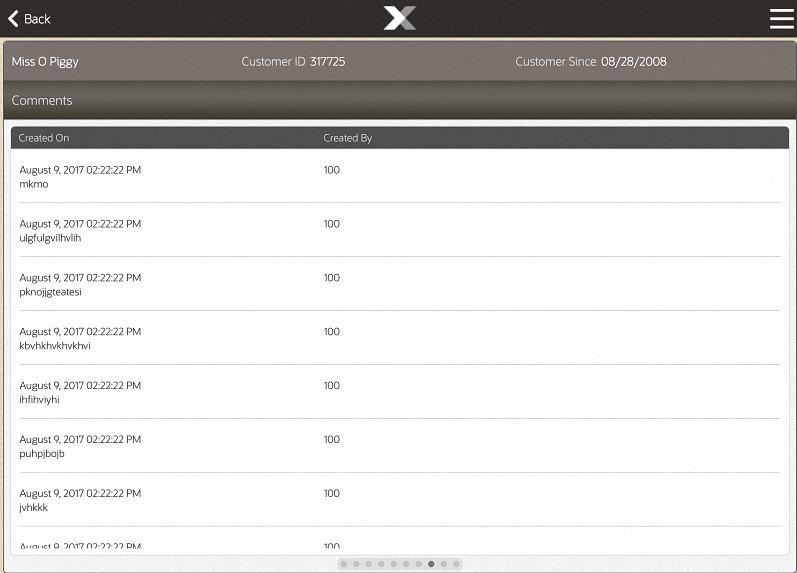
The Comments tab shows any comments associated with this customer. This tab displays the following information for each comment:
-
Created on: Information about when the comment was created, and the comment itself.
-
Created by: ID of the employee who entered the comment.
Adding a Comment
To add a comment:
-
If necessary, click Save Changes to save the customer record.
Note:
When creating a new customer, comments cannot be added until the information for the customer has been saved.
-
Click Add Comment.
An Add Comment window opens.
-
Enter the comment.
-
Click OK.
The comment is saved and added to the customer record.
Addresses Tab
Figure 29-11 Customer Maintenance - Addresses Tab

The Addresses tab shows all the addresses associated with the customer. This tab displays the following information for each customer address:
-
Address Type: Type of address. For example, Home, Work, or Primary.
-
Address: The address.
To make changes to the addresses for a customer, perform the appropriate procedure:
-
Add an Address - Add an address to a customer record.
-
Edit an Address - Edit an address assigned to a customer record.
-
Designate a Primary Address - Change the primary address for a customer.
-
Delete an Address - Remove an address from a customer record.
Figure 29-12 Customer Maintenance - Address Menu
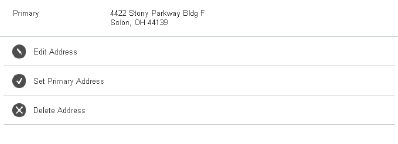
Add an Address
To add an address for a customer:
-
From the Context Menu select Add Address.
An Add Customer Address window opens.
Figure 29-13 Customer Maintenance - Add Address
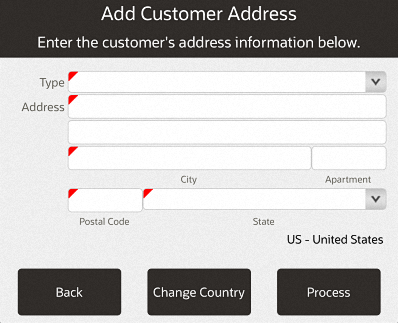
-
If necessary, change the country for the address. See Change Country.
-
If it is available, use Address Lookup to find the address.
-
If necessary, enter the address information:
Note:
Required fields are underlined for distinction.
-
Type: Type of address (for example, Home, Work, or Vacation).
-
Address: The first and second lines of the address.
-
Postal Code: Postal or zip code for the address.
-
State: State or province for the address.
-
City: City for the address.
-
Apartment: Apartment for the address.
-
Country: Country of the address. Click the Change Country button to change this value. See Change Country.
-
-
Click Process.
The address is added to the list of customer addresses.
Edit an Address
To edit an address for a customer:
-
Select the address to edit in the list of addresses:
-
Click the address.
-
-
Click Edit Address.
An Edit Customer Address window opens.
-
If it is available, use Address Lookup to find the address.
-
If necessary, make changes to the address information:
Note:
Required fields are underlined for distinction.
-
Type: Type of address (for example, Home, Work, or Vacation).
-
Address: The first and second lines of the address.
-
Postal Code: Postal or zip code for the address.
-
State: State or province for the address.
-
City: City for the address.
-
Apartment: Apartment for the address.
-
Country: Country of the address. Click the Change Country button to change this value. See Change Country.
-
-
Click Process.
The address is added to the list of customer addresses.
Designate a Primary Address
To change the primary address for a customer:
-
Click the address.
-
Click Set Primary Address.
Xstore opens a confirmation prompt.
Figure 29-14 Customer Maintenance - Set Primary Address
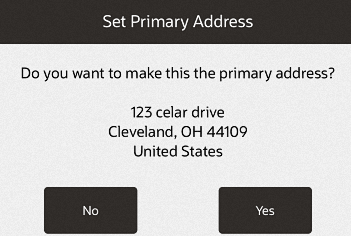
-
Click Yes in the confirmation prompt.
Click No if it is the incorrect address. Xstore returns to the Addresses tab.
Note:
Click No if it is the incorrect address. Xstore returns to the Addresses tab.
The address is set as the primary address for the customer. The new primary address is displayed on the top of the list of customer addresses.
Delete an Address
To delete an address from a customer record:
-
Select the address to delete in the list of addresses:
Note:
You cannot delete the primary address for the customer.
-
Click Delete Address.
Xstore opens a confirmation prompt.
-
Click Yes in the confirmation prompt to delete the address.
Note:
Click No to return to the Addresses tab without deleting an address.
The address is deleted from the customer record.
House Account Tab
Figure 29-15 Customer Maintenance - House Account Tab

The House Account tab displays the following types of information about the customer's house account:
-
House Account Details - Details about the house account.
-
Authorized Buyers - Information about each buyer authorized to use the house account.
-
Journal - Information about each activity performed on the house account.
Note:
This information is only available for customers who have set up a valid house account.
To make changes to the information in the House Account tab:
-
Change House Account Status - Change the status of a house account.
-
Change House Account Limit - Change the credit limit for a house account.
-
Change Authorized Buyers - Make changes to the authorized buyers associated with a house account.
House Account Details
This section displays the following information about the house account:
-
Account #: ID number for the house account.
-
Status: Status of the account: OPEN, HOLD, or CLOSED.
-
Corporate Account: If Yes, this is a corporate House Account and cannot be changed.
-
Account On-Hold: If Yes, this account cannot be used for purchases; however, payments can be made on the account.
-
Setup Date: Date the account was created.
-
Last Activity Date: Date of the most-recent activity on the account.
-
Last Payment Date: Date of the most-recent payment on the account.
-
Last Payment Amount: Most-recent payment amount on the account.
-
Credit Limit: Credit limit on the account.
-
Balance: Balance amount on the account.
-
Available Credit: Difference between the credit limit and the outstanding balance on the account that is available for purchases.
Authorized Buyers
This section displays the following information about the people authorized to use the house account:
-
Primary: A green check mark is displayed in this column for the primary authorized buyer for the account.
-
Buyer ID: House account ID of the buyer.
-
Name: Name of the buyer.
-
Start: Date on which the buyer is first permitted to use the account.
-
End: Date on which the buyer is no longer permitted to use the account.
Journal
This section displays the following information for each activity performed on the account:
-
Date: Date of the activity.
-
Store: ID of the store where the activity took place.
-
Trans #: ID number for the transaction in which the activity took place.
-
Account ID: ID of the house account.
-
Name: Name of the customer.
-
Type: Type of activity performed.
-
Amount: Amount of the activity.
-
Balance: Balance of the account following the activity.
Change House Account Status
To make changes to a customer's house account:
-
From the Context Menu when on the House Account page, select Change Status.
A Change Account Status window opens.
Figure 29-16 Change Account Status Window

-
Select the new status for the account:
-
HOLD: The authorized buyer cannot use the account for new purchases but can make payments on the account. The edit options for account limit and authorized buyer options are not available for accounts that are on hold.
-
CLOSE: The house account is no longer available for any activity.
-
REINSTATE: An account with a status of HOLD can be activated again by selecting this option.
-
OPEN: An account with a status of CLOSED can be activated again by selecting this option.
The status of the house account is changed.
-
Change House Account Limit
To change the credit limit for a house account:
-
From the Context Menu, select Edit Credit Limit.
A House Account Information window opens with the current credit limit for the account.
Figure 29-17 Customer Maintenance - House Account Credit Limit

-
Enter the new credit limit for the house account.
-
Click Process.
The credit limit for the house account is changed to the new value.
Change Authorized Buyers
A house account can have more than one buyer associated with it. To make changes to the authorized buyers for a house account, use the appropriate procedure:
-
Add an Authorized Buyer - Add an authorized buyer to a house account.
-
Edit an Authorized Buyer - Edit information for an authorized buyer.
-
Deactivate an Authorized Buyer - Deactivate an authorized buyer.
-
Designate a Primary Buyer - Change the primary buyer to another person.
Add an Authorized Buyer
To add an authorized buyer to a house account:
-
From the Context Menu, select Add Buyer.
An Add Buyer window opens.
Figure 29-18 Customer Maintenance - House Account Add Buyer

-
Enter the information for the buyer:
Note:
Required fields are underlined for distinction.
-
First Name: First name of the new buyer.
-
Last Name: Last name of the new buyer.
-
Start Date: Date on which the buyer will first be permitted to use the house account.
-
End Date: Date on which the buyer will no longer be permitted to use the house account.
-
-
Click Process.
The name of the new authorized buyer is listed in the Authorized Buyers section of the House Account tab.
Edit an Authorized Buyer
To edit an authorized buyer associated with a house account:
-
From the Context Menu, select Edit Buyer.
An Edit Buyer window opens.
Figure 29-19 Customer Maintenance - House Account Edit Buyer

-
Select the buyer to edit.
-
Enter the updates for the buyer:
Note:
Required fields are underlined for distinction.
-
First Name: First name of the new buyer.
-
Last Name: Last name of the new buyer.
-
Start Date: Date on which the buyer will first be permitted to use the house account.
-
End Date: Date on which the buyer will no longer be permitted to use the house account.
-
-
Click Process.
The information for the buyer is updated in Xstore.
Deactivate an Authorized Buyer
To deactivate an authorized buyer associated with a house account:
-
Click Deactivate Buyer.
A Deactivate Buyer window opens.
Figure 29-20 Customer Maintenance - House Account Deactivate Buyer
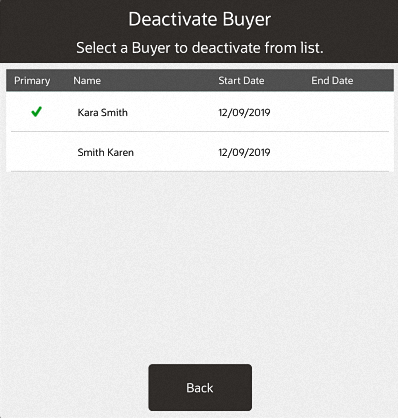
-
Select the buyer to deactivate.
The End Date for the selected buyer is set to today's date.
Designate a Primary Buyer
To change the primary buyer for a house account:
-
From the Context Menu, select Set Primary Buyer.
A Set Primary Buyer window opens.
Figure 29-21 Customer Maintenance - House Account Set Primary Buyer
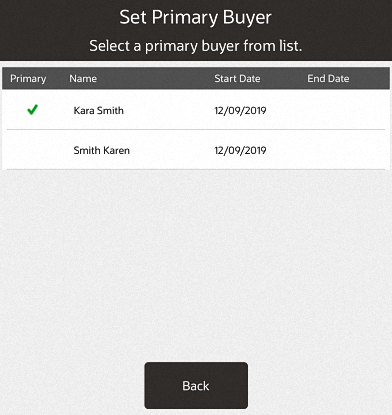
-
Select the buyer to designate as the primary buyer:
-
Select the buyer.
The selected buyer is designated as the primary buyer and moved to the top of the Authorized Buyers list, with a green check mark next to their name. The list is sorted alphabetically below the primary buyer's name.
-
Wish List Tab
Figure 29-22 Customer Maintenance - Wish List Tab

If Xstore is integrated with Oracle Retail Customer Engagement, this tab displays any items in the customer's personal wish list. A customer account may have multiple wish lists associated with it, but only one wish list can be viewed at a time. To view another wish list, select the Wish List Options button then select Another Wish List option.
This tab displays the following information for each wish list item:
-
Item ID: ID of the item.
-
Description: Description of the item.
-
Orderable: Indicates whether the item can be ordered.
Selecting the individual line and images are displayed. Touching outside of the image box makes the image disappear and take you back to the list.
Figure 29-23 Customer Wish List Context Menu

Figure 29-24 New Wish List
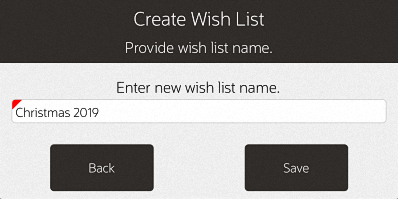
Figure 29-25 Customer Wish List Report

